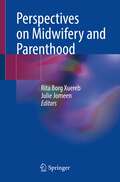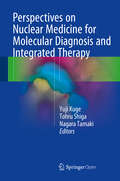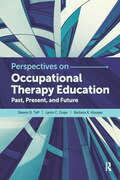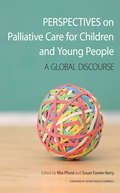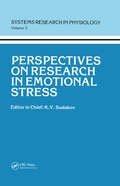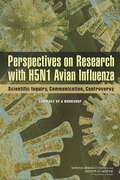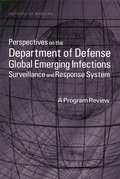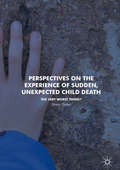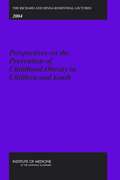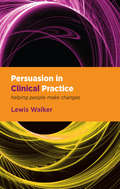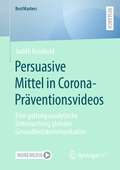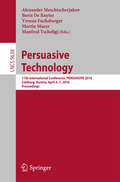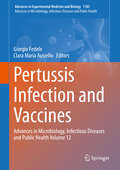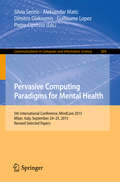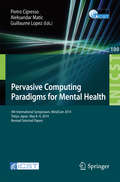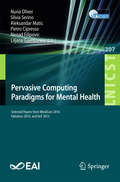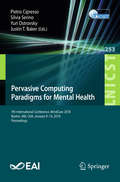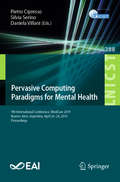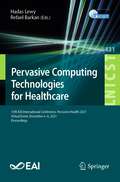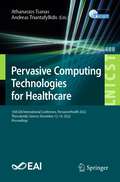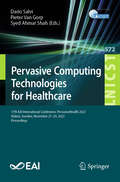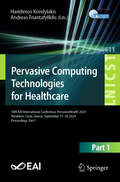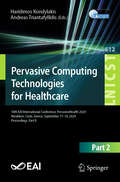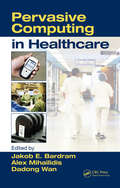- Table View
- List View
Perspectives on Midwifery and Parenthood
by Julie Jomeen Rita Borg XuerebThe book Perspectives on Midwifery and Parenthood explores contemporary issues relating to parenthood and midwifery. This book bridges a gap in the literature, where it highlights the close and unique relationships that midwives, nurses, doctors, other health care professionals and students enjoy with women and men during their transition to parenthood. Midwives work in close contact with and address the diverse needs of women and men during one of the most critical life's transitions, preconception, pregnancy, childbirth and early parenting and its long term implications on the psychosocial, emotional, physical and spiritual wellbeing of parents and infants. The chapters cover the transition and preparation for parenthood, midwives and parental-fetal-tie in pregnancy, perinatal mental health, maternal well-being, infertility, repeated loss and surrogacy, supporting early parenting following preterm birth, adolescent pregnancy and early parenthood, social challenges and parenthood including drug and alcohol use in pregnancy, intimate partners’ violence, migrants and transition to parenthood, fathers’ transition to parenthood, diversity of family formation - LGBTQ+ parents, breastfeeding, the role of spirituality during pregnancy, and midwifery and parenthood. Each person is unique and so is the response to parenthood, as the mother, father and family embark on this new lifeworld, a lifelong commitment. The book is a compendium of contemporary research depicting the strengths, opportunities, and recommendations how midwives and other health care professionals can nurture optimal, compassionate, respectful person- and family-centred care during pregnancy and early parenting, the transition to parenthood.
Perspectives on Nuclear Medicine for Molecular Diagnosis and Integrated Therapy
by Yuji Kuge Tohru Shiga Nagara TamakiThis work is devoted to understanding the recent advances in nuclear medicine and molecular imaging technologies along with their application to integrated medical therapy and future drug development. This anthology is based on the international symposium in 2015 entitled "Perspective on Nuclear Medicine for Molecular Diagnosis and Integrated Therapy. "The symposium provided an opportunity to exchange ideas on how to promote nuclear medicine technology and how to extend the technology to medical therapy and drug development, and was also a good opportunity to discuss the future perspective of nuclear medicine and molecular imaging by worldwide leaders in the field. Molecular imaging technologies have been rapidly developed worldwide in recent years. Among those developments, nuclear medicine has come to play an important role in quantitative analysis of biological process in vivo as well as in wide clinical use. With the current progress of nuclear medicine and molecular imaging, this modality has been applied for treatment monitoring and predicting its outcome with the use of optimal imaging biomarkers and suitable quantitative analysis. Truly, a new era has arrived with clinical use of nuclear medicine and molecular imaging for personalized medicine. This volume will benefit a wide variety of researchers in life science including those working in drug development, molecular imaging, and medical therapy as well as physicians who utilize diagnostic imaging.
Perspectives on Occupational Therapy Education: Past, Present, and Future
by Barbara Hooper Steven Taff Lenin GrajoPerspectives on Occupational Therapy Education: Past, Present, and Future outlines a path forward for occupational therapy educators, incorporating the impact of historical context, contemporary issues and trends, and international viewpoints on the development of the profession.With this mission in mind, Drs. Steven D. Taff, Lenin C. Grajo, and Barbara R. Hooper offer helpful tips, practical tools, and fresh insights to support current and future educators in developing their teaching philosophies and pedagogies. The book is divided into three main sections—past, present, and future—and examines:• The history of occupational therapy education, including the influence of critical philosophies, their relationship to higher education and healthcare, and the growth of accreditation standards and professional degree programs.• Current trends and challenges in healthcare and higher education, including bridging the gap between education and practice, the use of competency exams, expanding educational research, and promoting diversity and inclusion among faculty and students.• International perspectives on the development and future of occupational therapy education from leading scholars in Africa, Australia, Europe, North America, South America, and Southeast Asia, including trends in educational technologies, fieldwork education and requirements, and inter-professional education.An indispensable resource for educators, Perspectives on Occupational Therapy Education: Past, Present, and Future concludes with an imagining of the occupational therapy education landscape in the year 2050: a future in which occupational therapy educators are continuously responding to ongoing changes in health care policies, adapting to a more diverse and globally connected student population, and articulating the distinct value of occupational therapy in new and emerging areas of practice.Included with the text are online supplemental materials for faculty use in the classroom.
Perspectives on Palliative Care for Children and Young People: A Global Discourse
by Rita Pfund Susan Kerry-FowlerAdvances in medical science and technology are saving the lives of more children worldwide than ever. Some survive and live out a normal life expectancy, others have a life-limiting/life-threatening diagnosis where death may come early, and still others will live on well past projected life trajectories into adulthood. With so many different care pathways, children, parents and communities often find themselves facing challenges for which neither they nor their healthcare systems are prepared. This book opens a global discussion of these issues. Extending Rita Pfund's text Palliative Care Nursing of Children and Young People, it invites paediatric palliative care professionals, parents and children from around the globe to share their knowledge and experience. This book is of vital interest to palliative care professionals, parents, policy makers and academics. It is an important move towards ensuring that all children and their families, regardless of geographical location, gender, ethnicity or socio-economic class have equal and guaranteed access to comprehensive paediatric palliative care services.
Perspectives on Research in Emotional Stress
by Detlev Ganten Nicola A. Nikolov K.V. SudakovFirst Published in 1989. Based on the updated proceedings of the Soviet-American International Pavlovian Conference held in Moscow, this volume presents a new trend in the systems analysis of emotional stress as an outcome of behavioural conflict situations in which the subjects fail to achieve a useful end result. The mechanisms, complications, prevention and behavioural therapy of emotional stress are examined. While almost any of the body functional systems can be involved, psychosomatic and immune system disorders, coronary heart diseases and hypertension are shown to be the major complications of chronic exposure to emotional stress in both humans and animals. A special section of the book highlights various approaches towards the enhancement of stress resistance in man through emotional self-regulation, relaxation, social skills training and other biobehavioural interventions.
Perspectives on Research with H5N1 Avian Influenza
by Institute of Medicine National Research Council Forum on Microbial Threats Policy and Global Affairs Board on Global Health Division on Earth and Life Studies Board on Life Sciences Anne-Marie Mazza Committee on Science, Technology, and Law Steven Kendall Karin MatchettWhen, in late 2011, it became public knowledge that two research groups had submitted for publication manuscripts that reported on their work on mammalian transmissibility of a lethal H5N1 avian influenza strain, the information caused an international debate about the appropriateness and communication of the researchers' work, the risks associated with the work, partial or complete censorship of scientific publications, and dual-use research of concern in general. Recognizing that the H5N1 research is only the most recent scientific activity subject to widespread attention due to safety and security concerns, on May 1, 2012, the National Research Council's Committee on Science, Technology and Law, in conjunction with the Board on Life Sciences and the Institute of Medicine's Forum on Microbial Threats, convened a one-day public workshop for the purposes of 1) discussing the H5N1 controversy; 2) considering responses by the National Institute of Allergy and Infectious Diseases (NIAID), which had funded this research, the World Health Organization, the U.S. National Science Advisory Board for Biosecurity (NSABB), scientific publishers, and members of the international research community; and 3) providing a forum wherein the concerns and interests of the broader community of stakeholders, including policy makers, biosafety and biosecurity experts, non-governmental organizations, international organizations, and the general public might be articulated. Perspectives on Research with H5N1 Avian Influenza: Scientific Enquiry, Communication, Controversy summarizes the proceedings of the workshop.
Perspectives on the Department of Defense Global Emerging Infections Surveillance and Response System: A Program Review
by Committee to Review the Department of Defense Global Emerging Infections Surveillance Response SystemPerspectives on the Department of Defense Global Emerging Infections Surveillance and Response System: A Program Review describes the capacity, quality, and effectiveness of the international and domestic facilities and programs that are a part of a DoD system to monitor and address emerging infectious diseases globally. The committee concludes that the goals of the system are in U.S. military, U.S. civilian, and global public health interests and that substantial progress has been made toward achieving system goals.
Perspectives on the Experience of Sudden, Unexpected Child Death
by Denise TurnerThis book combines autobiography and innovative narrative research to create an original psychosocial perspective on the often taboo subject of sudden, unexpected child death. Beginning with the author's own experience, the book investigates manifold aspects of sudden, unexpected child death, including the professional rapid response; contemporary cultural reactions to death; theories of grieving; child death inquiries and popular media reporting. At the heart of the book are intimate personal stories, drawn from unprecedented psychosocial research on this topic, which combine to create a unique record of parent's experiences following the sudden and unexpected death of a child. Additionally, the book offers original guidance on the Biographic Narrative Interpretive methodology, which extends knowledge of group data analysis. The book will be of great methodological interest to the psychosocial community, as well as to health and social care professionals and lay readers interested in both sudden, unexpected child death and the wider field.
Perspectives on the Prevention of Childhood Obesity in Children and Youth
by Institute of Medicine of the National AcademiesThe National Academies Press (NAP)--publisher for the National Academies--publishes more than 200 books a year offering the most authoritative views, definitive information, and groundbreaking recommendations on a wide range of topics in science, engineering, and health. Our books are unique in that they are authored by the nation's leading experts in every scientific field.
Persuasion in Clinical Practice: Helping People Make Changes
by Lewis WalkerBy the end of this book you are going to be part of an exclusive group. The skill-sets you are about to learn will help you become one of a select few who can, time and time again, help people make changes in any clinical encounter.A" Persuading and influencing are most effective as cooperative ventures that recognise the needs and wishes a person already has, but feels unable or disempowered to decide or act upon. Persuasion in Clinical Practice aims to improve outcomes for patients by helping them to change their own attitudes and behaviours more easily in pursuit of better health and well-being. Drawing on fields such as motivational interviewing, the Stages of Change model, positive psychology and neuro-lingusitic programming (NLP), the book provides skills and tactics to help clinicians avoid communicational roadblocks, find what is really important to patients, why they want it, and then empower them to make changes in key areas such as: * lifestyle adjustments * coming to terms with chronic or serious illness * learning coping strategies and behaviours * overcoming fear of change. Encompassing a five-step strategy for any change consultation, Persuasion in Clinical Practice is packed with information and approaches to enhance knowledge, skills, attitudes and understanding in influencing change. This book will be essential reading for family doctors and other health professionals supporting behavioural change in their patients.
Persuasive Mittel in Corona-Präventionsvideos: Eine gattungsanalytische Untersuchung globaler Gesundheitskommunikation (BestMasters)
by Judith ReinboldIn diesem Buch werden 199 Videoclips, in denen Gesundheitsbehörden aus 17 Ländern Corona-Präventionsmaßnahmen nahelegen auf persuasive und gestalterische Mittel hin untersucht. . In einer soziologischen, qualitativ orientierten Medienproduktanalyse kristallisieren sich vier wesentliche inhaltliche Überzeugungsmittel heraus, nämlich sachliche Informationen, soziale Einflüsse, Zukunftsszenarien und Furchtappelle. Im Rahmen einer Gattungsanalyse werden diese als variable Merkmale der Binnenstruktur erfasst, die auf eine neu entstehende kommunikative Gattung bzw. Form (Corona-Präventionsvideos) hindeuten.
Persuasive Technology
by Alexander Meschtscherjakov Boris De Ruyter Verena Fuchsberger Martin Murer Manfred TscheligiThis book constitutes therefereed proceedings of the 11th International Conference on PersuasiveTechnology, PERSUASIVE 2016, held in Salzburg, Austria, in April 2016. The 27 revised full papers and 3 revised short papers presented were carefullyreviewed and selected from 73 submissions. The papers are grouped in topicalsections on individual differences, theoretical reflections, prevention andmotivation, methods and models, games and gamification, interventions forbehavior change, and design strategies and techniques.
Persönlichkeit braucht Tugenden
by Gerhard Danzer Josef RattnerSpielen im 21. Jahrhundert Tugenden eigentlich noch eine Rolle? Der Autor beschreibt in seinem Buch neun Charakterzüge und Wesensmerkmale, die für die Entwicklung eines Menschen seiner Meinung nach von Bedeutung sind. Dazu gehören beispielsweise Besonnenheit, Hingabe, Humor, aber auch Vornehmheit. Ein Buch, mit dem der Autor auf unterhaltsame Art und Weise zum Nachdenken über die eigenen Tugenden anregt.
Pertussis Infection and Vaccines: Advances in Microbiology, Infectious Diseases and Public Health Volume 12 (Advances in Experimental Medicine and Biology #1183)
by Giorgio Fedele Clara Maria AusielloThis book provides a comprehensive overview of pertussis - also known as whooping cough. The first part discusses the evolution the genus Bordetellae and the molecular epidemiology of B. pertussis, while the following chapters focus on the role of B. pertussis virulence factors in infection and disease and on the mechanisms of the immune response to infection and vaccination. The book also explores the prevention and control of the disease as well as its clinical management, with the finally section addressing vaccination, from improved immunization strategies to novel vaccines.Pertussis remains one of the most poorly controlled vaccine-preventable diseases around the globe. Universal vaccination has dramatically reduced its incidence but has failed to bring it completely under control. In recent decades, changes in pertussis epidemiology have been noted, likely related to the use of acellular pertussis vaccines, which in many countries have replaced older-generation, whole-cell pertussis vaccines. Several years after their introduction, it is becoming apparent that immunity conferred by acellular vaccines wanes more rapidly than expected. Unlike whole-cell vaccines, acellular vaccines, while protecting against the disease, do not seem to prevent colonization and transmission. Increasing incidence among adolescents and adults makes them a reservoir for transmission to unimmunized infants, who in turn are at risk of severe disease and death. This book is a valuable resource for researchers and clinicians in the field of medical microbiology, vaccine research and infectious diseases.
Pervasive Computing Paradigms for Mental Health
by Silvia Serino Aleksandar Matic Dimitris Giakoumis Guillaume Lopez Pietro CipressoThis book constitutes the refereed proceedings of the 5th International Conference on Pervasive Computing Paradigms for Mental Health, MindCare 2015, held in Milan, Italy, in September 2015. The 23 full papers and 6 short papers presented were carefully reviewed and selected from 40 submissions. The papers deal with the use of technologies in favor of maintaining and improving mental wellbeing. They focus on building new computing paradigms and on addressing a multitude of challenges in mental healthcare, for example in psychiatric and psychological domains with emphasis on new technologies, such as video and audio technologies and mobile and wearable computing.
Pervasive Computing Paradigms for Mental Health
by Aleksandar Matic Guillaume Lopez Pietro CipressoThis book constitutes revised post-proceedings of the 4th International Symposium on Pervasive Computing Paradigms for Mental Health, MindCare 2014, held in Tokyo, Japan, in May 2014. The 11 full and 5 short papers presented were carefully reviewed and selected from 26 submissions for inclusion in the proceedings. The papers are organized in topical sections on recognition and assessment, mental health management, improving communication, depression, and self-applied treatments.
Pervasive Computing Paradigms for Mental Health: 4th International Symposium, Mindcare 2014, Tokyo, Japan, May 8-9, 2014, Revised Selected Papers (Lecture Notes of the Institute for Computer Sciences, Social Informatics and Telecommunications Engineering #100)
by Liljana Gavrilovska Silvia Serino Aleksandar Matic Pietro Cipresso Nenad Filipovic Nuria OliverThis book constitutes the refereed proceedings of the 6th International Symposium on Pervasive Computing Paradigms for Mental Health, MindCare 2016, held in Barcelona, Spain, in November 2016, and the Second International Conference of Future Access Enablers of Ubiquitous and Intelligent Infrastructures, Fabulous 2016, Belgrade, Serbia, October 24-26, 2016, and the Third International Conference on Interoperability in IoT, IIoT 2015, Rome, Italy, October 26-27, 2015. The 24 papers were selected from 32 submissions. MindCare presents technologies in favor of maintaining and improving psychological well-being. Fabulous presents broad areas of future wireless networks, ambient and assisted living and smart infrastructures in order to interact, exchange ideas, expertise, experience and know-how. And finally IIoT presents tools and services in home automation and industrial service.
Pervasive Computing Paradigms for Mental Health: 7th International Conference, MindCare 2018, Boston, MA, USA, January 9–10, 2018, Proceedings (Lecture Notes of the Institute for Computer Sciences, Social Informatics and Telecommunications Engineering #253)
by Silvia Serino Pietro Cipresso Yuri Ostrovsky Justin T. BakerThis book constitutes the refereed proceedings of the 7th International Conference on Pervasive Computing Paradigms for Mental Health, MindCare 2018, held in Boston, MA, USA, Jin January 2018. The 19 papers presented were carefully reviewed and selected from 30 submissions and present advanced computing and communication technologies from the use of wearable sensors and ecological virtual environments to use of big data and machine learning techniques. These technologies can be used to support and promote the well-being through an objective continuous data collection and personalized
Pervasive Computing Paradigms for Mental Health: 9th International Conference, MindCare 2019, Buenos Aires, Argentina, April 23–24, 2019, Proceedings (Lecture Notes of the Institute for Computer Sciences, Social Informatics and Telecommunications Engineering #288)
by Silvia Serino Pietro Cipresso Daniela VillaniThis book constitutes the refereed proceedings of the 9th International Conference on Pervasive Computing Paradigms for Mental Health, MindCare 2019, held in Buenos Aires, Argentina, in April 2019. The 22 papers presented were carefully reviewed and selected from 38 submissions and present new paradigms in mental healthcare, in parallel with compelling questions about how it is possible to promote and structure these changes to improve physical well-being.
Pervasive Computing Technologies for Healthcare: 15th EAI International Conference, Pervasive Health 2021, Virtual Event, December 6-8, 2021, Proceedings (Lecture Notes of the Institute for Computer Sciences, Social Informatics and Telecommunications Engineering #431)
by Hadas Lewy Refael BarkanThis book constitutes the refereed proceedings of the 15th International Conference on Pervasive Computing Technologies for Healthcare, Pervasive Health 2021, held in December 2021. Due to COVID-19 pandemic the conference was held virtually. The 28 full and 7 short papers were selected from 74 submissions and are organized in 3 main tracks: hospitality and community care, homecare and medical education. The COVID 19 pandemic was challenging all dimensions of Pervasive Health (PH) and traditional ways of monitoring, diagnosing, treating and communicating changed dramatically.
Pervasive Computing Technologies for Healthcare: 16th EAI International Conference, PervasiveHealth 2022, Thessaloniki, Greece, December 12-14, 2022, Proceedings (Lecture Notes of the Institute for Computer Sciences, Social Informatics and Telecommunications Engineering #488)
by Athanasios Tsanas Andreas TriantafyllidisThis book constitutes the refereed proceedings of the 16th EAI International Conference on Pervasive Computing Technologies for Healthcare, PervasiveHealth 2022, which took place in Thessaloniki, Greece, in December 2022.The 45 full papers included in this volume were carefully reviewed and selected from 120 submissions. The papers are organized in the following topical sections: personal informatics and wearable devices; computer vision; IoT-HR: Internet of things in health research; pervasive health for COVID-19; machine learning, human activity recognition and speech recognition; software frameworks and interoperability; facial recognition, gesture recognition and object detection; machine learning, predictive models and personalised healthcare; human-centred design of pervasive health solutions; personalized healthcare.
Pervasive Computing Technologies for Healthcare: 17th EAI International Conference, PervasiveHealth 2023, Malmö, Sweden, November 27-29, 2023, Proceedings (Lecture Notes of the Institute for Computer Sciences, Social Informatics and Telecommunications Engineering #572)
by Pieter Van Gorp Dario Salvi Syed Ahmar ShahThis book constitutes the refereed proceedings of the 17th EAI International Conference on Pervasive Computing Technologies for Healthcare, PervasiveHealth 2023, held in Malmö, Sweden, during November 27-29, 2023. The 29 full papers and 6 short papers were selected from 90 submissions and are organized in thematic sessions as follows: Pervasive Mental Health; Privacy, Ethics and Regulations; Datasets and Big data Processing; Pervasive health for Carers; Pervasive Health in Clinical Practice; Remote Monitoring; Patient and User Aspects; Motion and rehabilitation; Workshop on the Internet of Things in Health Research; Posters and demos (non indexed annex).
Pervasive Computing Technologies for Healthcare: 18th EAI International Conference, PervasiveHealth 2024, Heraklion, Crete, Greece, September 17–18, 2024, Proceedings, Part I (Lecture Notes of the Institute for Computer Sciences, Social Informatics and Telecommunications Engineering #611)
by Andreas Triantafyllidis Haridimos KondylakisThe two-volume set LNICST 611 and LNICST 612 constitutes the refereed proceedings of the 18th EAI International Conference on Pervasive Computing Technologies for Healthcare, PervasiveHealth 2024, held in Heraklion, Crete, Greece, during September 17–18, 2024. The 45 full papers included in these proceedings were carefully reviewed and selected from 120 submissions. They were split in topical sections as follows: Part I : Patient Empowerment; Artificial Intelligence; Medical Imaging; Education. Part II : Education; mHealth and Telemonitoring; 3rd IOT-HR: Workshop on Internet of Things in Health Research; Posters
Pervasive Computing Technologies for Healthcare: 18th EAI International Conference, PervasiveHealth 2024, Heraklion, Crete, Greece, September 17–18, 2024, Proceedings, Part II (Lecture Notes of the Institute for Computer Sciences, Social Informatics and Telecommunications Engineering #612)
by Andreas Triantafyllidis Haridimos KondylakisThe two-volume set LNICST 611 and LNICST 612 constitutes the refereed proceedings of the 18th EAI International Conference on Pervasive Computing Technologies for Healthcare, PervasiveHealth 2024, held in Heraklion, Crete, Greece, during September 17–18, 2024. The 45 full papers included in these proceedings were carefully reviewed and selected from 120 submissions. They were split in topical sections as follows: Part I : Patient Empowerment; Artificial Intelligence; Medical Imaging; Education. Part II : Education; mHealth and Telemonitoring; 3rd IOT-HR: Workshop on Internet of Things in Health Research; Posters
Pervasive Computing in Healthcare
by Jakob E. Bardram Alex Mihailidis Dadong WanWith skyrocketing costs due to the increase in the elderly population, a rapid increase in lifestyle-related and chronic diseases, demand for new medical treatments and technologies, and a shortage in the number of available clinicians, nurses, and other caregivers, the challenges facing the healthcare industry seem insurmountable. However, by tra
